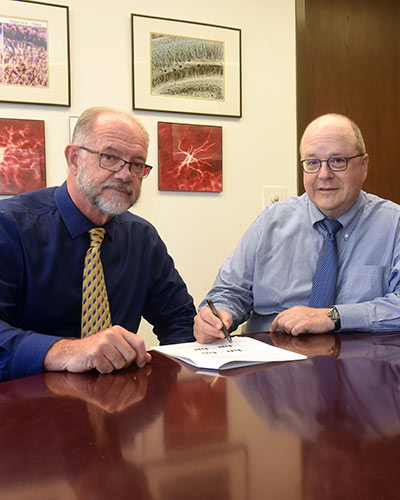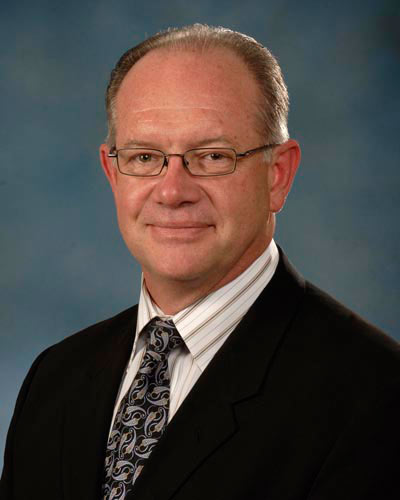June 14, 2018

Idea Developed by Two University of Maryland School of Medicine Scientists; New Clinical Study Corroborates Their Theory
For years, researchers have debated whether the use of pure oxygen was a good idea for treating cardiac arrest victims. Two University of Maryland School of Medicine (UMSOM) researchers helped pioneer the idea that this treatment could actually harm the brains of cardiac arrest patients. Now, after decades of research a new clinical study for the first time provides clear evidence that their approach appears to be correct.
The researchers, Robert E. Rosenthal, MD, professor of emergency medicine at UMSOM and director of hyperbaric medicine in the R Adams Cowley Shock Trauma Center, and Gary Fiskum, PhD, the M. Jane Matjasko Professor for Research and vice-chair of research in the Department of Anesthesiology, were not involved in this clinical study, which was recently published in the journal Circulation. However, their prior work paved the way for this research.
Cardiac arrest occurs when the heart’s electrical system breaks down, leading it to stop beating or to beat in a disordered way. Without blood, the brain, lungs, and other organs stop working very quickly. To survive without damage, a patient must typically be resuscitated within about five minutes.
The two researchers have performed research at UMSOM for over 20 years. Over that time they have questioned the standard clinical practice of providing 100 percent oxygen to cardiac arrest survivors following resuscitation. “Since it has been known for many decades that pure oxygen can be toxic to the retina and lungs,” says Dr. Fiskum, “we hypothesized that administration of very high oxygen for even a few hours following resuscitation could cause further damage to the brain.”
Dr. Rosenthal had extensive experience with cardiac arrest resuscitation in emergency departments, and suspected that 100 percent oxygen might not be helping these patients. He developed laboratory animal models to test this hypothesis, with the help of Dr. Fiskum’s expertise in oxygen free radical biology and brain energy metabolism. They soon found that continuous exposure to 100 percent oxygen during just the first hour following resuscitation resulted in toxic oxidation of certain brain molecules and inhibition of brain energy metabolism. Their results challenged the fundamental support for widespread use of oxygen following resuscitation from cardiac arrest.
Cardiac arrest victims are generally older than 65 and often have respiratory problems that can limit the uptake of oxygen. Dr. Rosenthal devised a post-resuscitation protocol that would control oxygen intake to avoid both too little oxygenation and too much oxygenation. This measured approach resulted in much better brain outcomes than the standard use of much higher levels of oxygen. In response to this work and to other clinical studies, in 2010, the American Heart Association (AHA) changed its treatment guidelines for ventilation after cardiac arrest, from 100 percent oxygen to the minimum level necessary to maintain blood oxygen saturation levels of between 94 and 96 percent, which avoids both too much or too little systemic oxygenation.
Despite the AHA guidelines, high levels of inspired oxygen are still frequently administered to survivors of cardiac arrest. Dr. Fiskum says that avoiding unnecessarily high supplemental oxygen after cardiac arrest could improve the neurologic outcomes for many of the 250,000 cardiac arrest victims in this country who are stricken every year outside of a hospital, and who are resuscitated.
Earlier this year, researchers from Cooper Medical School of Rowan University in New Jersey published a study in Circulation, which prospectively followed 280 patients who were resuscitated after cardiac arrest. The authors found that when blood oxygen levels exceeded three times the normal levels within six hours of resuscitation from cardiac arrest, neurologic outcomes were significantly worse than those exhibited by survivors with more normal blood oxygen levels. They concluded that their results support the avoidance of unnecessarily high levels of oxygen in these patients.
“This study validates what we found and what the American Heart Association has been recommending for seven years,” says Dr. Rosenthal. “We hope this work helps clarify this question even further.”
However, the situation remains complex. The study found that 65 percent of patients who were not exposed to high levels of oxygen had poor neurologic outcome, compared to 77 percent who were exposed to high levels of oxygen. So it remains important to find better ways to treat cardiac arrest patients. Drs. Rosenthal and Fiskum now have a five-year, $2.6 million grant from the National Institute of Neurologic Diseases and Stroke to study molecules and drugs that stimulate the expression of genes with anti-oxidant and anti-inflammatory properties. The goal of this work: to eventually help patients, just as their earlier work on high oxygen levels has.
“Dr. Fiskum and Dr. Rosenthal have studied this issue for many years, and have been pioneers in realizing that clinical practice needed to be changed,” says E. Albert Reece, MD, PhD, MBA, Executive Vice President for Medical Affairs at UM Baltimore, and the John Z. and Akiko K. Bowers Distinguished Professor and UMSOM Dean. “This latest research adds to the already strong evidence that their research has been both groundbreaking and crucially useful to patients and doctors.”
About the University of Maryland School of Medicine
Commemorating its 210th Anniversary, the University of Maryland School of Medicine was chartered in 1807 as the first public medical school in the United States. It continues today as one of the fastest growing, top-tier biomedical research enterprises in the world -- with 43 academic departments, centers, institutes, and programs; and a faculty of more than 3,000 physicians, scientists, and allied health professionals, including members of the National Academy of Medicine and the National Academy of Sciences, and a distinguished recipient of the Albert E. Lasker Award in Medical Research. With an operating budget of more than $1 billion, the School of Medicine works closely in partnership with the University of Maryland Medical Center and Medical System to provide research-intensive, academic and clinically-based care for more than 1.2 million patients each year. The School has over 2,500 students, residents, and fellows, and nearly $450 million in extramural funding, with most of its academic departments highly ranked among all medical schools in the nation in research funding. As one of the seven professional schools that make up the University of Maryland Baltimore campus, the School of Medicine has a total workforce of nearly 7,000 individuals. The combined School and Medical System (“University of Maryland Medicine”) has an annual budget of nearly $6 billion and an economic impact in excess of $15 billion on the state and local community. The School of Medicine faculty, which ranks as the 8th-highest public medical school in research productivity, is an innovator in translational medicine, with 600 active patents and 24 start-up companies. The School works locally, nationally, and globally, with research and treatment facilities in 36 countries around the world. Visit medschool.umaryland.edu/
Contact
Office of Public Affairs
655 West Baltimore Street
Bressler Research Building 14-002
Baltimore, Maryland 21201-1559
Contact Media Relations
(410) 706-5260
Related stories

Monday, February 26, 2018
New Technology for Use in Military Vehicles May Protect Troops from Blast-Induced Brain Injury
Researchers from the University of Maryland School of Medicine (UMSOM) and the University of Maryland A. James Clark School of Engineering have developed a new military vehicle shock absorbing device that may protect troops from traumatic brain injury (TBI) after a land mine blast. Over the past 18 years of conflicts in Iraq and Afghanistan, more than 250,000 troops have suffered such injuries.
